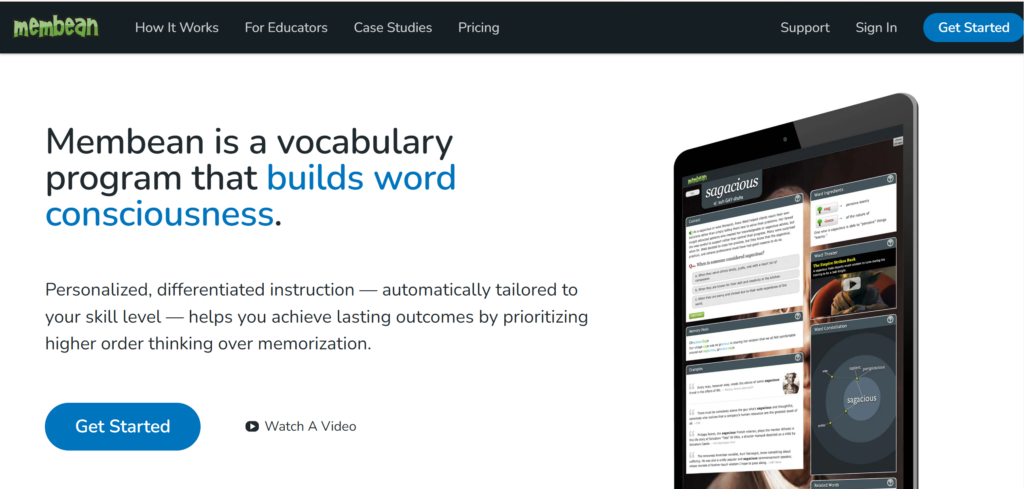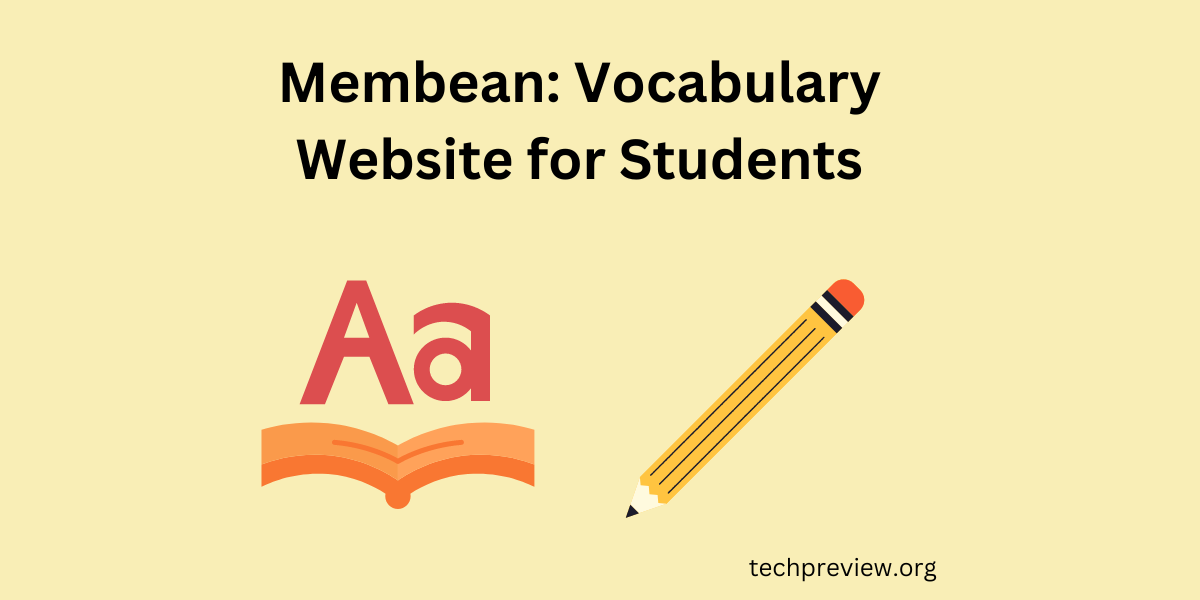Membean is a vocabulary website which offers varying word instruction to students of all abilities and ages like ELLs and those with dyslexia. In training sessions, students learn new words through various pathways. In addition to receiving the pronunciation of the word, students also use sample sentences, drawings, and pictures to represent new explanations, vocabulary, and definitions.
Through Membean, teachers can add students, create courses, and design and distribute assignments and assessments. Through its dashboard, teachers are also able to view report on individual student progress in learning as well as customizing various aspects of the site’s settings and other functions such as co-teachers invitation.
A teacher can create as many classes she/he wishes to. Every class has a special code that the student can use when self-enrolling. When developing a class, you will need to specify your training cycle and your expectations of trainees. Cycles and expectations are critical because they will enable you to set specific grading criteria and also assist the Membean engine in identifying when learners are ready for assessment.
Students can be invited to your classes via an email or cards-type enrollment. Otherwise, the students can sign up with a special URL that you provide them. Upon first time logging into their Membean account, they will be prompted to begin the calibration process that takes less than 5 minutes up to a maximum of 7 minutes.
What is the process of calibration?
This calibration process is similar to taking a placement test wherein students are asked a set of questions that Membean uses to determine your mastery over vocabulary. Students’ answers indicate that Membean calibrates students to a certain level. It is possible to go back over the student’s calibration process and judge if students were positioned at the proper classes.
The underlying goal of the calibration process is to ensure students receive customized vocabulary folders that fit their learning stage.
How does Membean work?
Thus, students train and improve their vocabulary through a variety of training sessions. During each lesson new words are presented and each word is a combination of 9 learning methods. Students have the freedom to choose what they want to learn and when.

If any student fails to learn a new word, Membean provides them with comprehension test questions in order to check whether they have learned or not and reduce their knowledge of the word.
Membean reports
The Membean reports are detailed and customizable concerning the students’ performance. Each session, access to performance information related to the training is available for teachers. Words and questions the students used during the training session, time spent on a given word or question, incorrect answers, new words studied, number of correct answers, and study of a term are only some of them.
Students learning is entirely under the control of their teachers. For example, they can personalize the duration and frequency of learning. They can also choose the number of questions in quizzes as well as their frequency.
Teachers are able to customize students’ training preferences in addition to enabling/disabling definition auto-play, dyslexic fonts, pronunciation auto-play, and full spelling.
Writing assignments and assessments
Personalized assessments, therefore, that are based on students vocabulary learning can easily be designed by teachers. Grading assessments is automatic and the results can be exported into a spreadsheet. To create or manage assessments for your classes, just log in to your dashboard using the name of your class, then the Assessments tab and click on the “Create Assessment” option.
Students can also use their words in context through written assignments. Each student receives a personalized writing project tailored to their training. As a teacher, you will be able to follow students’ progress as well as grade the assignments they submit( since writing assignments are really not auto-graded).
To make an assignment, please go to your dashboard and then select Assessments Writing and click on Create a Writing Assignment. Select the number of words, deadline and the type of cue. Tap on Create Assignment, and a unique assignment will be generated for each student.
What is the Membean cost?
Membean includes a graduated pricing plan, making it cheaper per student when several classes use the program. There is a tiered pricing model for Membean in which the price will depend on how many students you are purchasing it for. The per-student price varies between $6 and-20 per student, depending on the purchase size.
Contact them with your school name and the number of students and ELA teachers that would be involved in using the program.
Related Articles
- Animal:lxjjx7snyfs= Wolverine: Exploring the Life of a Fearless Predator
- The Changing Landscape of School Nurse Jobs: Trends and Challenges
- 99.7°F to Celsius: Why It’s Important and How to Convert It
- Aesthetic:hfyknqlyygs= Preppy Style: The Perfect Blend of Tradition and Modern Elegance in 2024
- The Correct Spelling Is School Not School Some Pe – Tymoff
- Gobi Desert: Asia’s Vast Wilderness Unveiled
- Drawing:cul23ybyzfm= Basketball: A Creative Exploration of the Game’s Dynamic Moments
Membean features for rigorous vocabulary development
Everyone knows there is a difference between teaching philosophy and the practical implementation of an efficient curriculum. The following are some of the key features that provide a demanding, individualized learning environment that encourages the development of learners’ word awareness.

Training Features
- Multimodal Learning: Each Word Page comes with all sorts of learning activities that teach the word in many ways, offering much variety to comprehend and embed the information deeply into memory. Various attention and motivation tools, such as spoken audio tracks, arresting images, videos, and fun memory hooks, are known to capture students’ attention and make them want to learn. Learning autonomy is gained from the existence of a choice menu and variety in each word to be learned.
- Accommodation and Differentiation: Some students of the same class need to have equal knowledge of vocabulary or requirements of learning. Students, therefore, start out their Membean training process by calibrating onto one of our expertly structured word lists. Teachers can personalize class set-up and student preferences to fit the needs of individual learners. Membean can, therefore, be used to test students at all levels.
- Scaffolded Questions: Students gradually advance to more complex questions when training. There are nine types of questions that can be used to increase as students become more familiar with the words.
- Curated Content: Information about Membean is not pulled from Google. The content team puts a lot of effort into all context paragraphs, for example, videos, sentences, images, and questions. Many content team members are English teachers. Middle and high school students are brought the right content for appropriateness and interest.
Classroom Features
- Customizable Training Expectations: The needs of different classes may be varied, so Membean allows teachers to set up training requirements based on their needs. They have recommendations for teachers too as they can know how much training is required by students to receive optimum benefits.
- Personalized Assessments: Teachers can quickly administrate assessments to students. All the assessments derive from a student’s Quizzable word list, hence, as preparation for assessments, all that students have to do is train. Students get instant feedback while taking a test because quizzes are graded automatically. This saves teachers the need to grade tests manually.
- Customizable Assessments: Moreover, teachers may personalize assessment difficulty through their selection of the number of select-all-that-apply (SATA) items. SATA questions help to improve the severity involved and promote students gaining the minute details of words.
- Writing Assignments: The ultimate purpose of learning vocabulary is to produce good writers. Teachers have four options in writing-related assignments for students to practice putting their words into action. Three of these alternatives involve cue sentences, encouraging students to create new ideas and avoid plagiarism.
- Student Tracking: Firstly, you can track all student activities from your dashboard with a single glance because of customizable reports. Membean has an uncompromising, methodical attitude regarding the maintenance of records that teachers can rely on what is reported and students can rest assured that their minutes would be written.
People May Also Ask
What does Membean mean?
Membean is a program for improving word consciousness. Individualized, customized instruction based on what you know and can relatedly do aims to deliver long-term results by emphasizing higher-order thinking instead of rote memorization.
Is Membean good or bad?
Reviews about Membean include a statement from one student in which he said, “I like it very much, and it works well. It is really easy to learn something from this resource.” Rating him 5 out of 5 stars. Many students would agree with this statement about Membean, but they may doubt the ‘recreation’ part of it.
In what grade is Membean used?
There are options for students who underperform in high school due to the designed grades sixth through twelfth in a program. A sixth grader who is severely behind – low literacy will have to begin at the middle school level 1. Membean presents various levels within the middle school model.
What age is Membean for?
Membean targets grades 6–12 and is made to individual needs.









